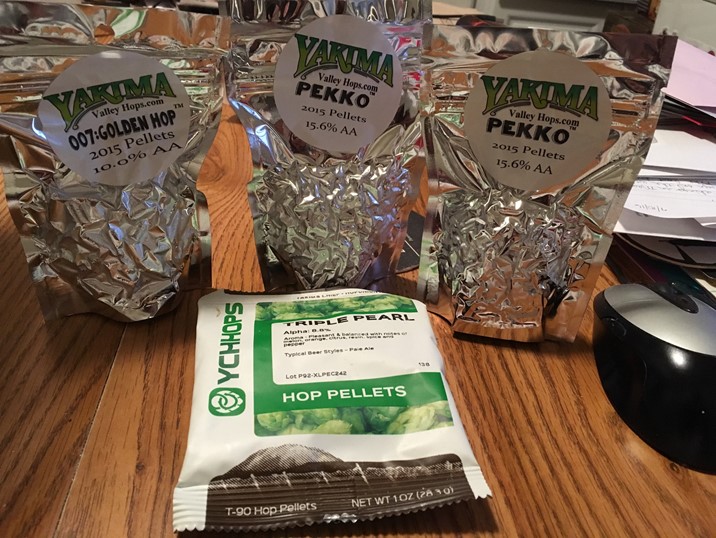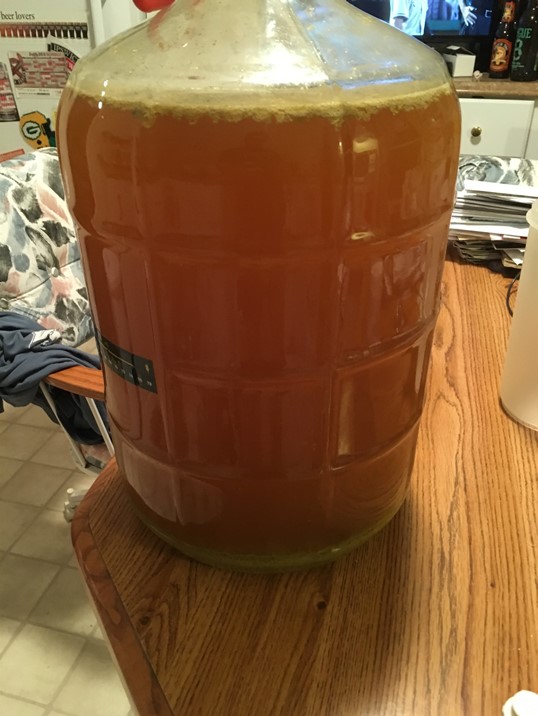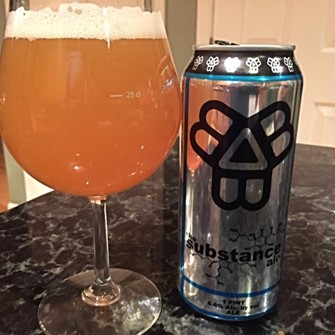The US of IPA is a project where I will brew four regionally inspired American IPAs. I will be pouring all four at the North Shore Brewers tent New England Homebrewers Jamboree. Jamboree is an event open to the public to benefit Make a Wish. Tickets are available here.
Commercial beers change over time. Even when they are purported to be the exact same as they have always been, they will evolve as ingredients and processes change. More often though, a commercial brewer will make changes to a beer that they think will make the beer better. One beer that has changed is Bissell Brothers The Substance. On the right is The Substance purchased in August 2014, and on the left is The Substance as it appears in August 2016.
When I cloned the beer two years ago the grist was 86% 2-row, 7% flaked barley, and 7% flaked rye. The finished beer was quite clear; especially compared to hazy New England IPAs. Over time the appearance of the beer has changed. Since I only pick up cans a few times a year it is easy for me to spot, but the beer has definitely gotten hazier.
Beyond just the appearance I do get a slickness in the mouthfeel consistent with oats, while I no longer get any noticeable rye flavor. Maybe this is just my visual bias, meaning I see a hazy beer and based on what I see I start to feel and taste things based on what I am seeing. With that caveat, my guess is that Bissell Brothers replaced the flaked rye with flaked oats. The hop flavor and aroma feels similar but if a blend of six or seven hops is changed it is hard to identify a major difference.
When I started planning my New England IPA for the US of IPA my starting point was The Sustenance, but I wanted to adjust the recipe to make the beer more like how The Substance is now and not how it was in 2014. I wasn't going to be married to the hops from The Sustenance recipe. On a podcast Noah Bissell said he designed The Substance to use less sought-after hop varieties. As a new, tiny brewer it would be difficult to obtain in-demand hops like Citra and Mosaic. In that spirit my original plan was to buy the least expensive American hops I could find and make a hazy version of The Sustenance. Then I realized I had all of these free hops from Homebrew Con. What is cheaper than free?
I used three new hop varieties. I had four ounces of Pekko which I found the aroma to be quite tart and citrusy, almost lime-like. I also had two ounces of 007 hops which I found to be equal parts citrusy, herbal and spicy. For my dry hops I added an ounce of Triple Pearle which was similar to 007, if perhaps a bit more spicy and peppery.

In the interest of variety, I switched out the base malt from The Sustenance with Pearl malt which is what The Alchemist is rumored to use in Heady Topper. Drawing further inspiration from Heady, I chose to use Vermont Ale yeast. The Conan strain as it's called has an obscenely high attenuation. It will convert more sugars into alcohol than almost any other British or American strain (Conan is rumored to be English in origin). I added a higher percentage of flaked oats and wheat to try and make sure the beer doesn't finish too dry.

I haven't used Conan in two years. When I last used it, I harvested some yeast and froze it for future use. When freezing yeast two things are critical: you need to blend in one-part glycerin and two parts water before freezing, and you need to make sure the yeast doesn't thaw at all in the freezer. The glycerin protects the yeast cell walls from being punctured by frozen water crystals. Thawing and refreezing, which is essentially how a frost-free freezer works, puts the yeast's cell walls at risk each time it freezes. To hedge against this, I packed the yeast in a bag with an ice pack to try and make sure the yeast stayed frozen.
To try and revive my frozen Conan I let it thaw slowly in the refrigerator. I then added it to a diluted 800ML yeast starter and let it go on my stir plate. It took almost two days for there to be the faintest sign of any fermentation. I didn't trust that I had enough viable cells, so I bought a package of Giga Yeast's Vermont IPA strain. The nice thing about their packaging is that it comes with a "double pitch" which contains double the cells that Wyeast or White Labs include in their packages. I was able to pitch the package directly into my wort while still ensuring I had a proper pitching rate.


This was the final batch I brewed (if not blogged about) as part of the project. I had planned to brew all of the US of IPA beers during my vacation. That turned out to be too much brewing in too short of a period of time. I brewed this batch on a Wednesday night during the biggest heat wave of the year. Even with my air conditioner on high all day, the temperature didn't get much below 80F. I was able to use a swamp cooler to allow my beer to ferment in the high 60s.

As a kicker while I was brewing I realized I still hadn't packaged Broken Fist. I had planned to take care of that on Sunday, but ended up going to Lynch Park for the Homecoming fireworks instead. The beer being in contact with the dry hops for a few extra days isn't the worst thing in the world. I am glad the beer wasn't in contact with the dry hops for more than two weeks. That would have imparted plenty of grassy notes. Especially with the amount of hops I used.
Click here for the recipe.
Follow me on Twitter @JChalifour
Like The Would-be Brewmaster on Facebook
Share what beers you are drinking with me on Untappd
Follow me on Twitter @JChalifour
Like The Would-be Brewmaster on Facebook
Share what beers you are drinking with me on Untappd


No comments:
Post a Comment